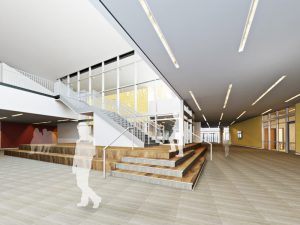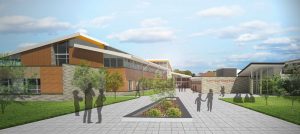by Mark McCarthy
We often refer to the early teen years as “the awkward years,” because it is both the most difficult time in an adolescent’s life as well as one of tremendous growth and maturity. It is a time when one’s world view turns outward and students begin to develop into who they will be. We also ask young teens to take on more responsibility in their education.
Beginning in sixth grade, or occasionally fifth, and extending to eighth grade, middle schools not only bear the responsibility of educating our children, but also help them to become independent learners and well-intentioned citizens of the world. This is clearly revealed in the school design as the curriculum transforms from a single teacher-led classroom, to one where teams of teachers focus on specialized subject areas while students travel from class to class.
Middle school architecture reflects this duality and supports the mission of the educators. Scale is very important, since the design needs to reflect a “step-up,” that will facilitate navigation, and not intimidate or hinder exploration. Arranging the classrooms in wings or clusters supports the team approach, particularly at the fifth and sixth grade levels when students tend to travel as a group. As students enter the seventh grade they travel more independently from class to class, and the transition to high school begins.
Additionally, transparency becomes the architectural equivalent of connectivity, allowing both teachers and students to see and be seen. This is a time when peer pressure can also play a positive role in a student’s life, inspiring them to try new things and display accomplishments.
Great school design needs to provide generous amounts of space for display and presentation. Twenty-first century students not only need to study, they also must be comfortable discussing and presenting ideas. A large commons or open space at the heart of the school provides an ideal, informal learning environment that supports this approach.
This central hub also acts as the heart of the school and fosters a strong sense of community at a time in life when students are beginning to find their footing in a larger world. A truly great middle school provides a physical space that supports this yearning.
While it is important to learn to work effectively in a group, schools must also recognize the importance of the individual, because each student’s approach to learning and new challenges is personal. This intimate scale can be reflected in a variety of ways.
Many students confide to us about their need for quiet, concentration time. Furniture that can be easily moved to create personal space in the library or media center provides an effective solution. The traditional library carrel is still relevant and can fill this need for privacy and concentrated individual study. Small niches or breakout spaces scattered throughout the hallways provide impromptu meeting or study space that can be so useful at this age.
These are areas where the use of transparency can allow for smaller groups or individuals to concentrate, but still facilitate faculty supervision.
Flexibility and adaptability is also critical to the design of a great school; therefore, it is more important than ever to anticipate change. While we cannot predict the future, we do know schools will continue to adapt to new teaching methodologies, technology, and modes of communication.
Architects and our clients must keep this in mind and create spaces with robust connectivity. Whenever possible, it is important to keep the design simple and modular, with walls that can be relocated without costly changes to the structure or mechanical systems. We caution our clients to guard against the hyper-specific space, and favor generous flexible rooms that can accommodate a variety of functions.
A successful middle school design must reflect the scale and optimism of this age group, with durable and easily maintained materials. There is something comforting and familiar about brick and stone, something timeless and substantial that seems particularly well-suited for a middle school. This doesn’t mean the design needs to be traditional or limit creativity. A really great middle school can be all these things — innovative and inspiring, safe and secure and, like its students, open to the world.
Mark McCarthy, AIA, LEED AP, is a principal at Perkins Eastman Architects.













